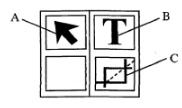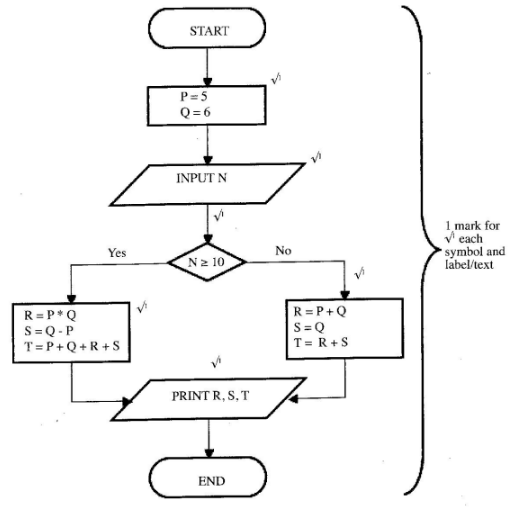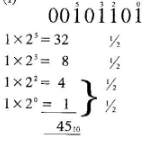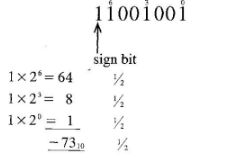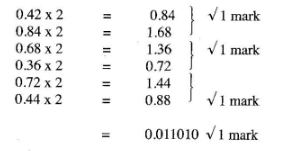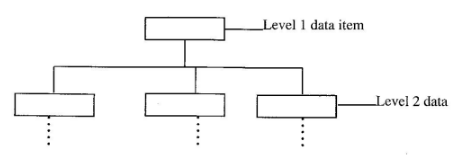SECTION A (40 marks)
Answer ALL the questions in the spaces provided.
- State two functions of the Control unit of a computer. (2 marks)
-
- Differentiate between hardware and software portability. (2 marks)
- State two disadvantages of CD-ROM over magnetic disks. (2 marks)
- One way in which an organisation enforces security of its computer systems is by restricting the use of removable media such as floppy disks and flash memories. Give two reasons for this. (2 marks)
-
- What is meant by Data Communication Equipment? (1 mark)
- List six examples of Data Communication Equipment. (3 marks)
- When purchasing a computer, the clock speed, RAM size, Hard disk size and monitor size are often quoted. State the unit for measuring: (2 marks)
- Clock speed; ..........
- RAM size:....
- Hard disk size.........
- Monitor size...
- Name three types of graphics used in a word processor. (3 marks)
- A student saved a document in a diskette. Later on, the student found that the diskette could not open and therefore the work got lost. Give three precautions the student should have taken to ensure the work was not lost. (3 marks)
- Differentiate between relative cell referencing and absolute cell referencing. (2 marks)
- State two:
- functions of an email software; (1 mark)
- protocols used in sending and receiving of emails. (1 mark)
- With reference to word processing, describe the term:
- superscript: (1 mark)
- section breaks. (1 mark)
- Describe the following types of relationships as used in Database design: (4 marks)
- One-to-one;
- One-to-many.
- State the stage of system development life cycle in which each of the following activities take place:
- determination of the cost-effectiveness of a system; (1 mark)
- interviews: (1 mark)
- replacement of an old system with a new one. (1 mark)
- The figure below is a toolbar for a DTP package.
State the functions of the tools labelled A, B and C. (3 marks) - State two roles of a programmer in system development life cycle. (2 marks)
-
- What is meant by disk defragmentation? (1 mark)
- State the purpose of disk defragmentation (1 mark)
SECTION B (60 marks)
Answer question 16 and any other THREE questions from this section in the spaces provided.
-
- State the use of each of the following flow chart symbols. (3 marks)
-
- Below is an algorithm that is used to compute the values of R, S and T.
P = 5
Q = 6
INPUT N
If N is GREATER OR EQUAL TO 10
R = P * Q
S = Q − P
T = P+Q+R+S
ELSE
R = P+Q
S = Q
T = R+S
END IF
PRINT R, S and T
From the algorithm, determine the output if the input value of N is:- 7; (3 marks)
- 10. (3 marks)
- Draw a flowchart for the algorithm in Question 16 (b). (6 marks)
- State the use of each of the following flow chart symbols. (3 marks)
-
- Convert each of the following binary numbers to decimal equivalent given that the left most digit is a sign bit.
- 00101101 (2 marks)
- 11001001 (2 marks)
- Convert the decimal number 0.42 to 6 bit binary notation. (4 marks)
- Using two's complement, subtract 1110 from 8010 leaving your answer in binary notation. (5 marks)
- Perform the following binary operation. (2 marks)
11001 + 1101 − 101
- Convert each of the following binary numbers to decimal equivalent given that the left most digit is a sign bit.
-
- State three techniques used by a network administrator to detect and prevent computer crimes.
(3 marks) - A company in town wishes to link its offices together. The linking may be through wireless or fibre optic network media.
- State two benefits that the company would gain from the use of metropolitan area network (MAN). (2 marks)
- State three advantages of using wireless over fibre optic network media. (3 marks)
- State two limitations of wireless communication. (2 marks)
- State two transmission media used in wireless transmission (2 marks)
- State three ways in which computer virus infection can be prevented other than through restricting the usage of removable storage media. (3 marks)
- State three techniques used by a network administrator to detect and prevent computer crimes.
-
-
- What is an information system? (1 mark)
- State two roles of an information system. (2 marks)
- Describe the following file organisation methods:
- random file organisation; (2 marks)
- sequential file organisation. (2 marks)
- The following records were extracted from two files that contained student data.
File A:
Reg. No. Student Name Sex Address
3002 Christine Onyancha F Box 8932 Kisii
3008 John Otieno M Box 7222 Nairobi
3001 Amina Muthee F Box 1243 Butere
3015 Peter Musyoki M Box 6621 Nyeri
File B:
Reg. No. Fees Payments Date of Payment
3002 1000 04/05/2011
3008 1500 03/09/2011
3001 900 02/09/2011
3015 400 21/09/2011- Which of the two files above represents a Transaction file? (1 mark)
- Give a reason for your answer in c(i) above. (1 mark)
- Name the other type of file represented above. (1 mark)
- An airline uses an information system whereby if a passenger at station A books a plane scat, this transaction is immediately shown at stations A and B such that no other passenger can book the same seat.
- Identify this data processing mode. (1 mark)
- State two advantages and two disadvantages of this data processing mode. (4 marks)
-
-
- With the aid of a diagram, describe the Hierarchical Database Model (4 marks)
- List three factors that should be considered when developing a database application and give reasons why each should be considered. (6 marks)
-
- Name three types of validation checks during data entry (3 marks)
- Differentiate between primary key and index key. (2 marks)

MARKING SCHEME
-
- To direct the operations of the internal processor components.
- To control the flow of programs and data in and out of main memory.
- To read and interpret program instructions.
- To control flow of information to and from all the components of the computer,
- To control flow of information/data
- To determine next instruction to be executed first.
- To fetch instructions from devices.
- To direct/give/monitor operations of internal processing.
- To send control signals to peripherals.
(any 2 x 1 = 2 marks)
-
-
- Hardware portability refers to the ease of moving hardware from one location to another while
- Software portability refers to the ability of running software on different platforms/models/ hardware/computers.
(2 marks)
- Disadvantages of CD ROM over magnetic disks.
- Fairly fragile - easy to break or scratch than magnetic disks.
- Smaller storage capacity than a hard disk.
- CD ROM have a slower data access time compared to magnetic disks.
- Takes time to save/write data than magnetic disk.
- CD ROM not re-writable.
(2 ×1 = 2 marks)
-
-
- To minimise/control spread of viruses.
- To control access to data/programs.
- To control movement of data.
- To control unauthorized access to data/information.
(2 marks)
-
- Any equipment/device that passes on a network signal. (1 mark)
- Modem, Bridges, Gateway, Repeaters, Brouters, Routers, Cables, NIC, hubs/Switches, codec, computer, multiplexer/demltiplexer, Nanostations, phone.
(First 6 x ½= 3 marks)
- Units
- clock speed - hertz, gigahertz, megahertz
- RAM size - bytes
- HD size - bytes/bits
- Monitor size - inches or
(½ x 4 = 2 marks)
-
- Drawings/shapes/dimensions/symbols/callouts
- Templates/clip art
- Photographs/pictures/scanned images/digital images
- Charts
- Graphics text/word art
(any 3 @ 1 mark each = 3 marks)
-
- Should have kept a back-up.
- Store the diskette safely e.g. in a disk bank.
- Use more reliable storage media.
- Regular scanning.
- Avoid ejecting disk while in use.
-
- Relative referencing, there is use of a formula whose references keeps on changing automatically depending on their relative position when they are copied from one cell to another.
- In Absolute referencing, the cells referenced are specific.
(2 marks)
-
-
- Facilitates mail creation.
- Facilitates reading mails.
- Facilitates sending mails
- Maintain a mailing list
- Keeping track of number of emails.
- Editing and composing mails.
- Advertising
- Creating email accounts/social networking list.
- Maintain contacts/address list.
- Deleting mails.
(any 2@ ½ mark each)
- SMTP, IMAP, POP3, MIME, HTTP (any 2@½mark each)
-
-
- Superscript - A character printed slightly above the normal line/text usually in smaller type.
(1 mark) - Splitting/dividing a document in order to apply different styles to each section. (1 mark)
- Superscript - A character printed slightly above the normal line/text usually in smaller type.
-
- An association between two tables in which the primary key value of each record in the primary table corresponds to the value in the matching field or fields of one and only one record in the related table. (2 marks)
- An association between the tables in which the primary key value of each record in the primary table corresponds in the value matching field or fields of many records in the related table.
(2 marks)
-
- Preliminary investigation requirements specifications/feasibility ✓1
- Requirement analysis/fact finding data gathering/information gathering and maintenance ✓1
- Implementation stage and maintenance ✓1
(1 mark x 3 = 3 marks)
- A: Selection tool - used for selecting/choosing/highlighting objects on the work area.✓1 (1 mark)
B: Text tool - used for enabling typing/editing or insertion of text. ✓1 (1 mark)
C: Cropping tool - used for trimming graphics. ✓1 (1 mark) -
- Coding/writing constructing (building) the system.
- Turning system specification into an information system,
- Modify existing programs to meet changes in information processing needs (maintenance)
- Implementing/installing a system
- Testing a new system
- Developing system program
- Documenting/giving technical guide
(first 2 x 1 = 2 marks)
-
- The process of rewriting parts of a file to contiguous sectors on a disk. (1 mark)
- Purpose
- to increase the speed of access and retrieval of files.
- to increase space on the disk space
(1 mark)
-
-
- An entry from, or an exit to another part of the program flowchart that is within the same page.
It is an on page connector. (1 mark) - A connector used instead of the connector symbol to designate entry to or exit from a page.
It is an off page connector (1 mark) - The beginning and/or end in a program.
To start and/or stop/terminate in a program. (1 mark)
- An entry from, or an exit to another part of the program flowchart that is within the same page.
-
- P= 5
Q = 6
N=7
IF N ≥ 10 THEN
ELSE
R=P+Q= 5 + 6 = 11
S = Q = 6
T=R+S= 11 +6 = 17
R S T
11 6 17
(Working 1½ @½, mark each)
(Answer 1½ @½ mark each) - P=5
Q = 6
N = 10
R=P* Q = 5+ 6 = 30
S=Q−P=6−5=1
T=P+Q+R+S= 5+6 +30 + 1 = 42
R S T
30 1 42 (3 marks)
(Working 1½ @½ mark each)
(Answer 1½ @½ mark each)
- P= 5
-
-
-
-
-
-
Mark correct for those who use the two's or one's complement correctly.
-
-
- 1110 = 10112 (1 mark)
8 = 10002 (1 mark)
Two's complement of 1110 = 0101 ( 1 mark)
0101
+1000
1101 (2 marks) - 11001
+1101
100110
− 101
1000012 (2 marks)
-
-
-
- Audit trail
- Use of antimalware software
- Data encryption
- Log files
- Firewall
- Intruder detection
- User access levels
- Password/Biometrics
any 3x1 = 3 marks)
-
-
- High speed communication
- Reduce data transfer charges
- Provides a secured network
- Allow remote access
- Media cannot be vandalised easily
(any 2 x 1 = 2 marks)
-
- No cumbersome cabling needed between sites.
- Support multi-channel transmissions.
- Wireless supports un-directed signals therefore allowing many recipients.
- Do not require access rights on the land between the buildings.
- (first 3 x 1 = 3 marks)
-
- Line of sight requirement.
- Expensive towers required/high initial cost.
- Subject to interference such as passing radio waves and weather conditions.
- Very difficult to restrict access if it is un-directed.
- Hard to secure
- Easy to hack
(first 2 x 1 = 2 marks)
-
- Satellite
- Microwave
- Radio waves/blue-tooth/infrared
(first 2 x 1 = 2 marks)
-
-
- Firewalls
- Antivirus
- Policy formulation on the usage of internet/password/security
- Using email instead of storage devices to transfer document files.
- Use genuine/authentic/unpirated software
(first 2 x 1 = 2 marks)
-
-
-
- Information system is an arrangement of people, data, processes, communication and IT that interact to support problem solving.
-
- Improve day-to-day operation
- Support problem solving
- Support decision making needs for management
- Data capture
- Processing data into information
- Data security
- Storing of data/information
(any 2 for 2 marks)
-
- Stored and retrieved according to their disk address which is generated by use of an algorithm or formula i.e. stored randomly, accessed randomly. (2 marks)
- Method of storing or retrieving information that requires the program to start reading at the beginning and continue until it finds the desired data. (2 marks)
-
- File B.
- Transaction file: It contains data which is regularly added.
Has data/fee payment - Master File: It contains records that do not change regularly like in file A.
½x 2 for name, I mark x 2 = reasons = 3 marks)
-
- Real time processing. (1 mark)
- Advantages
- Information is readily available for instant, decision making.
- Updating is done instantly when transaction occurs.
- Auditing is easier.
- It is accurate
- Prevent double booking
(any 2 x 1 = 2 marks)
Disadvantages - Complex - difficult to configure/set up.
- Expensive to acquire and maintain.
- Errors that occur are difficult to correct
(any 2 x 1 = 2 marks)
-
-
-
(level 1)
(level 2)
(2 marks)- Data items are arranged in a tree like format.
- Access is through a single path and all from one single item called the root component.
(1 mark x 2 = 2 marks)
- Factors
- Complexity of data/user needs/user friendliness
- Security and integrity
- Complexity of DBMS
- Volume of data/size
- Software compatibility with existing DBMS
- Cost of the data base
(any 3 x 1 = 3 marks)
Reasons - Complexity of data - Complex data requires complex DBMS
- Security and integrity - Data which is intended to be secured in terms of access, can be handled by complex DBMS which provides for such requirements.
- Complexity of DBMS - Complex DBMS do require complex skills, hence more training. It is therefore costly to run/use such system.
- Volume of data - Voluminous data require to be ran on stable application. They also take up extra computer system resources.
- Software compatibility - enables pre-existing databases to be exported to the new one.
(corresponding explanation x 3 = 3 marks)
-
-
- Field type/data type
- Field size
- Format
- Reasonableness
- Range constraint
- Presence check
(any 3x 1 = 3 marks)
- Any index key is a database feature used to speed up search and sort operations in a table; whereas
a primary key is a field that enforces uniqueness in a table so that one record is not entered twice or
a primary key is a field that uniquely identifies each record.
(1 mark ×2 = 2 marks)
-
-
Download KCSE 2012 Computer Studies Paper 1 with Marking Scheme.
Tap Here to Download for 50/-
Get on WhatsApp for 50/-
Why download?
- ✔ To read offline at any time.
- ✔ To Print at your convenience
- ✔ Share Easily with Friends / Students

